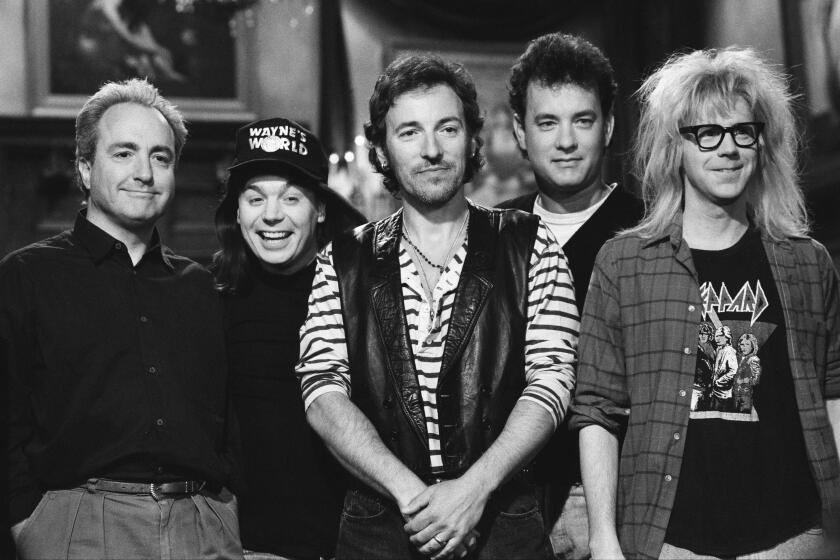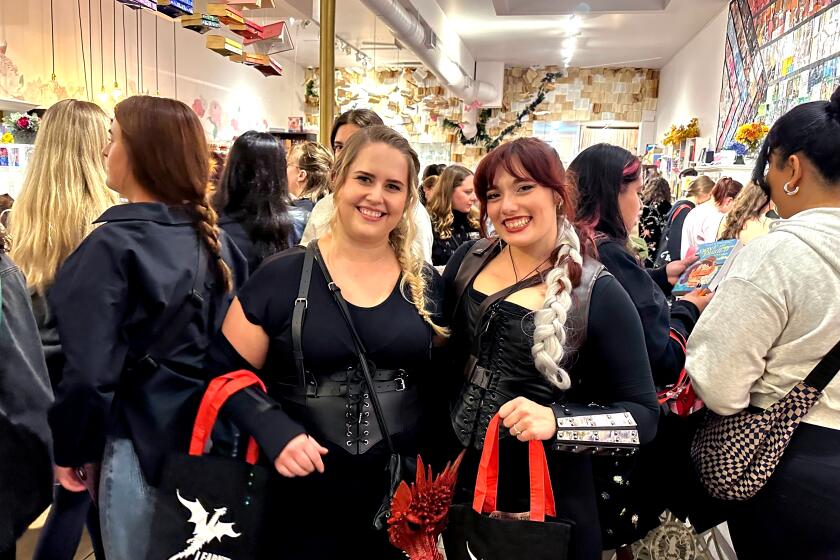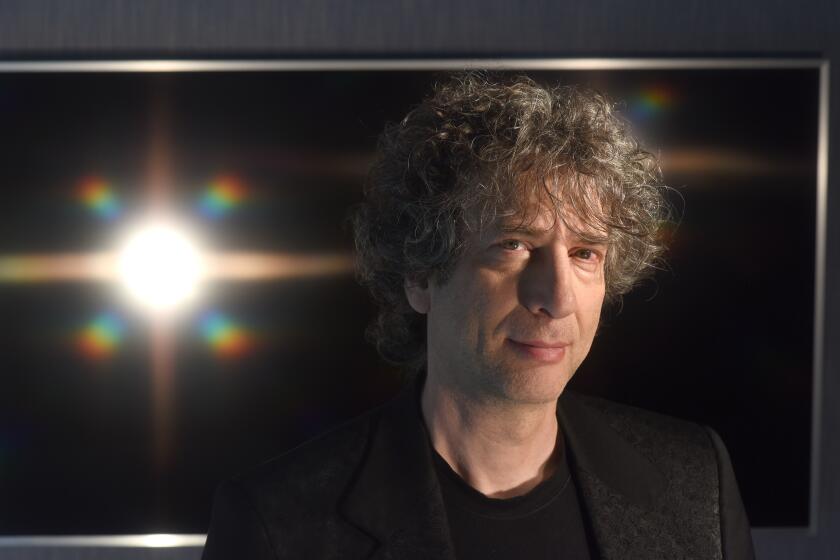An Odyssey in ‘Dear Dirty’ Dublin
- Share via
It is said that if Dublin were ever destroyed, it could be rebuilt from the pages of James Joyce’s books. Indeed, the city’s streets, landmarks and denizens populate Joyce’s masterwork, “Ulysses,” in such a meticulous, frank way that Dublin seems transformed into a living character.
Much has changed in the Irish capital in the century since Leopold Bloom, the cuckolded Jewish antihero of “Ulysses,” took his 18-hour journey through its streets on June 16, 1904. The city’s youthful, energetic demeanor as the capital of a European Union nation only faintly resembles the constrained British colonial city of the novel.
Last April, with the approaching centennial of Bloomsday, as Bloom’s odyssey is called, I traveled to Dublin to see how much I could unearth of the sights of “Ulysses.” Would I be able to find the essence of Joyce’s hometown -- the humor and humanity of the city’s residents? Martello Tower, Nelson’s Pillar, Glasnevin Cemetery, Davy Byrnes pub -- these are some of the places that were frequented by characters in “Ulysses,” and I sought them out in an effort to comprehend the intricacies of the book.
The 18-chapter structure of “Ulysses” parallels Homer’s “Odyssey.” Each is stylistically different from the next, an innovative technique when the book was published in 1922. But it was Joyce’s use of stream-of-consciousness dialogues and monologues to convey the inner thoughts of his characters that was groundbreaking and influenced such luminaries as Virginia Woolf, William Faulkner and Toni Morrison.
Joyce has even shaped popular American culture, with numerous references to “Ulysses” in TV shows and movies. Leopold Bloom is the name of the nervous accountant-hero in Mel Brooks’ “The Producers.” In the Tony award-winning Broadway musical, Bloom imagines the fame resulting from the scheme he hatches with his partner, and one of the characters jokes that perhaps there will be a Bloomsday in his honor.
As a writer, I wanted to understand what is considered one of the most important novels of the 20th century. Years ago I picked up a copy of “Ulysses” and tried to read it on my own. But I was intimidated by its reputation and complexities, so it sat, unread, until last winter, when my friend Millie Kidd, a professor of English at Mount St. Mary’s College in Los Angeles, invited me to a seminar on “Ulysses” and its prequel, “A Portrait of the Artist as a Young Man.”
In one class, Kidd shared a book of black-and-white photographs, taken in 1954, that showed “Ulysses” sites. The photos made the novel come alive, so I decided to embark on a Joycean pilgrimage -- an effort to make “Ulysses” more tangible and, perhaps, more intelligible.
Soon after I arrived, I met with Irish Sen. David Norris, a renowned Joycean scholar and chairman of the city’s James Joyce Centre. He is credited -- and blamed -- with popularizing Bloomsday.
Norris looks every bit the senator and retired Trinity College don. We trundled off to the cafeteria in Leinster House, the seat of the Irish Parliament, and over coffee chatted about “Ulysses,” Dublin and Joyce. Our conversation helped explain Joyce and his impact on contemporary American life.
“America loves novelty, loves the new, loves the experimental,” Norris said. “The American experience -- a lot of it -- is urban, and Joyce is the great poet of city life.”
Norris lives in a restored Georgian townhouse on North Great George’s Street, almost directly across from the James Joyce Centre and down the road from Belvedere College, which Joyce attended in the 1890s.
“I moved into that street 25 years ago,” Norris said. “It had been one of the great streets of 18th century Dublin, and then it had fallen into ruin, which meant I was able to buy a house quite cheaply.”
To get a sense of Norris and Joyce’s neighborhood, I walked the next morning to North Great George’s Street from my hotel, the Shelbourne on St. Stephen’s Green, passing along the way some of the places where Bloom had tarried. I crossed the River Liffey at the wide O’Connell Bridge and paused next to the General Post Office, or GPO, where Nelson’s Pillar once stood.
“Before Nelson’s Pillar trams slowed, shunted, changed trolley,” Joyce wrote in “Ulysses,” “started for Blackrock, Kingstown and Dalkey, Clonskea, Rathgar and Terenure. . . .” Gone are the trams that traversed O’Connell Street, but the crowds are still here, crossing hurriedly by car, bus or foot.
In “Ulysses,” vendors sold plums at the base of the stone monument, and “two Dublin vestals . . . elderly and pious . . . begin to waddle slowly up the winding staircase, grunting, encouraging each other, afraid of the dark, panting, one asking the other have you the brawn. . . .”
To Irish nationalists, Nelson’s Pillar symbolized Britain’s domination over Ireland, and in 1966 the Irish Republican Army dynamited it and the enormous statue of Adm. Horatio Nelson that sat atop it. In its place, the 394-foot Dublin Spire, a polished stainless-steel sculpture, now pierces the sky. The spire is sterile and sleek and cannot be climbed, and it evoked no Joycean voices.
I rambled north on O’Connell Street, retracing the funeral procession of Bloom’s friend Paddy Dignam. He died of a heart attack, though Bloom thought it was from “too much John Barleycorn.”
Veering right, off the funeral route, I turned onto Parnell Street, formerly Great Britain Street, and then left onto North Great George’s Street. The narrow block is lined neatly to the sidewalk with Georgian townhouses. The street is rich with links to “Ulysses” and its author.
The James Joyce Centre, at No. 35, is in a restored townhouse built in 1784. Abandoned and roofless in the 1980s, it was deemed a nuisance and scheduled for demolition when neighbor Norris intervened.
“I thought perhaps there might be a connection between it and James Joyce,” Norris said, so he researched the deed. “In 1904, the tenant of the back parlor was Denis Maginnis,” Norris explained. “I knew I’d struck oil. He’s a small, minor character in ‘Ulysses’ -- Professor Denis J. Maginni.”
Both the real and fictional Maginnis, who removed the ‘s’ from their surnames so they would sound Italian and thus attract more clients, ran a dance academy there.
As I examined the center’s modest red brick exterior, I did not suspect the grand scale of the rooms inside. The high, ornate plaster ceilings in the upstairs rooms have been painstakingly restored by modern Irish craftsmen using photographs of the original chambers. As I stood inside I could almost hear the music as Professor Maginni put one of his students through her paces in the back parlor.
Upstairs, the Guinness Library contains a comprehensive collection of Joyce’s works, including criticism and translations. The Leon Room next door holds furniture from the apartment in Paris where he worked on “Finnegans Wake.”
In the courtyard is the door to No. 7 Eccles St., the Blooms’ home and among the most sacred of sites to “Ulysses” fans. Molly, Bloom’s wife, had an adulterous affair here, uttering the novel’s renowned last words: “and yes I said yes I will Yes.”
The house was demolished in the 1970s.
I asked the center’s director, Helen Monaghan, why such an important address from Joyce’s Dublin had not been preserved.
“Joyce had a love/hate relationship with the country,” said Monaghan, whose paternal grandmother was Joyce’s sister. “He was persona non grata in the ‘50s and ‘60s, but now his work is part of the curriculum in schools.”
Joyce’s frank portrayal of the human failings of his countrymen won him few friends and made him an outcast in his homeland. Despite his Jesuit education, his rejection of Catholicism made him and his work heretical to the inhabitants of this mostly Roman Catholic island. At 22, Joyce exiled himself from Ireland to the Continent, returning only three times for brief visits. But until his death in 1941, he wrote about nothing but his “dear dirty Dublin.”
The next day i boarded the dart, Dublin’s suburban rail line, bound southeast for Sandycove and the Martello Tower, where “Ulysses” opens. One of several fortifications built along the Irish Sea coast in 1804 for defense against a feared invasion by Napoleon, Martello remained an army outpost for a century until Joyce’s friend, Irish poet and wit Oliver St. John Gogarty, became its first civilian tenant.
The literary and the literal cross paths frequently in “Ulysses.” Joyce briefly lived in the Martello with Gogarty in the summer of 1904. Stephen Dedalus is Joyce’s alter ego in the novel. Dedalus’ friend, Buck Mulligan, is a medical student modeled on Gogarty. Dedalus and Mulligan lived together in the Martello Tower.
The first publisher of “Ulysses,” Sylvia Beach, established the James Joyce Museum in the Martello in 1962. On display are the author’s letters, photographs, portraits and personal possessions, including his cabin trunk, guitar and cane, as well as such items as the original key to the tower and first and rare editions of Joyce’s works.
There were fewer than half a dozen people at the Martello the day I visited, and I was alone as I climbed the narrow steps to the parapet where Mulligan had gazed at the “snotgreen sea.” Just as Mulligan had, I peered out over the cold stone, but my view was soured by the single-family homes that surround its base.
Below is the Forty Foot Gentlemen’s Bathing Place, where Mulligan, Dedalus and other Irishmen performed their morning ablutions. On this gray morning, several mostly middle-aged men in bathing caps and swimsuits braved the frigid sea. I picked my way down steep stairs to the bathing place, clinging to rusted gray metal handrails and angling for a view of the Martello towering on the promontory above.
Later that afternoon I left Sandycove for the opposite end of Dublin in search of Glasnevin Cemetery, where Paddy Dignam was laid to rest early in “Ulysses.” It was an easy, short walk from the DART station, I was told, but none of the four maps I carried had details, and I became lost.
My confusion was fortuitous, for it echoed Bloom’s meandering journey to Glasnevin. Though he did not get lost, his carriage took a circuitous route to find fords over four waterways and was delayed while “a divided drove of branded cattle” and “raddled sheep bleating their fear” passed on the road. No livestock delayed my progress, but I crossed four waterways at least once each.
I asked a passerby for directions. He had a thick accent, slurred by what must have been a recent, lengthy visit to a pub.
“Up that road and to the right,” I thought he said.
I have since been told that the Irish don’t like to appear unfriendly, so if they don’t know the correct route, they will tell you something -- anything -- even if it is wrong. One hour and three “helpful” Dubliners later, I stood before Glasnevin’s iron gates. The cemetery was nearly deserted.
The burial ground, which became a cemetery in 1832, is the final resting place for more than a million souls. Mature trees shade row upon row of tombstones, some modest, some ornate. Each plot was neatly outlined and topped with gravel. Plastic flowers in clear plastic bowls had been lovingly placed on top.
The weathered markers had a stark, poignant beauty, and I felt transported to Bloom’s side, attending poor old Paddy Dignam’s funeral: “Holy fields. More room if they buried them standing. Sitting or kneeling you couldn’t. Standing? His head might come up some day above ground in a landslip with his hand pointing. All honeycombed the ground must be: oblong cells.”
On my return to central Dublin, I decided not to test the helpfulness of the Irish again and took a cab. Later that afternoon I followed Bloom’s path to Davy Byrnes pub by way of brick-paved Grafton Street, which is full of shops, as in 1904, though they now advertise in neon, plastic and chrome. On this weekend afternoon, the trendy pedestrian-only street was thick with shoppers and chatting, laughing youths.
I turned off Grafton, bound for Duke Street and the pub, where, after Dignam’s burial, “Mr. Bloom ate his strips of sandwich, fresh clean bread, with relish of disgust, pungent mustard, the feety savour of green cheese.”
It was not the Davy Byrnes of my imagination. I expected dark woods, marble and maybe some brass, smoky snugs -- those wee cubbyholes found in authentic Dublin pubs where one can have a bit of privacy even in a place crowded shoulder to shoulder. What I found was Formica, chrome, Lucite and bar stools upholstered in blue chintz. It was garish. And packed with all sorts of characters. At least that much was consistent with “Ulysses.”
An older gentleman, dapper in blue seersucker, red-eyed from an afternoon of refreshment, weaved toward the door. Two middle-aged women rescued their glasses of wine from their table as he made his way unsteadily past. They took a sip of wine and set the glasses back down, not missing a beat of conversation. A gaggle of smartly dressed young women, happily clutching shopping bags from the chic shops on Grafton, appeared at the door and quickly claimed the gentleman’s table.
I quaffed a pint of Guinness, then meandered back to my hotel, taking the paths of Bloom, Joyce and Dedalus. My search for the Dublin of “Ulysses” had been realized in a place that least resembled the past.
“What Joyce records is a wonderful, rich seam of life which is human, profound and enriching and frail and mortal and fallible,” Norris had told me.
Dublin may have changed physically, but the world Joyce created is very much alive. It is, after all, the essence of people that Joyce meant to convey.
I can imagine Joyce sitting today in Davy Byrnes pub, or Leinster House, or walking the city’s streets, observing characters and drawing them in words. Dublin still is a city full of Molly Blooms, Buck Mulligans and Paddy Dignams -- the characters of a 21st century “Ulysses.”
All one has to do is be mindful of them.
*
GUIDEBOOK
Retracing James Joyce’s Dublin
Telephone numbers and prices: The country code for Ireland is 353. All prices are approximate and computed at a rate of 0.8 euros to one U.S. dollar. Room rates are for a double for one night.
Getting there: Aer Lingus offers nonstop flights from Los Angeles International Airport to Dublin. Swiss, Continental, Lufthansa and Delta have connecting flights. American and United connect to Aer Lingus in Chicago, and British Airways, Air New Zealand, Virgin Atlantic and United offer connecting service to British Midland and Aer Lingus in London.
Where to stay: The Shelbourne Hotel, 27 St. Stephen’s Green; 663-4500, fax 661-6006, www.shelbourne.ie. The historic hotel, founded in 1824, gets a mention in “Ulysses.” The constitution for the new Irish Free State was drafted in Room 112 in 1922. The decor of the rooms is a little worn, but the public areas are gorgeous. The better rooms, with views of St. Stephen’s Green, are at the front of the hotel. Rates: from $287, including breakfast.
Where to eat: Bang Cafe, 11 Merrion Row; 676-0898, www.bangrestaurant.com. A top-notch restaurant just down the street from the Shelbourne with modern, minimalist decor and closely spaced tables. The service and food are excellent. I had outstanding medallions of beef fillet with caramelized onions, field mushrooms and foie gras butter. It’s not where Joyce would have eaten, but it’s reflective of the prosperous, modern Dublin. Main courses: $13 to $29.
Davy Byrnes Pub and Restaurant, 21 Duke St.; 677-5217, www.davybyrnespub.com. The bar, billed as “Dublin’s most famous literary pub,” is tucked away off busy Grafton Street. The exterior maintains a look that could have been from Joyce’s time, but the interior appears greatly changed. Joyce was a customer of the “abstemious Davy Byrne” and Bloom visits the pub in “Ulysses.” Main courses: $11 to $17.
James Joyce events: Bloomsday 100, James Joyce Centre, 35 North Great George’s St.; 878-8547, www.jamesjoyce.ie. The center, located in a restored 18th century townhouse, contains a comprehensive Joyce library and the door to Bloom’s house, No. 7 Eccles St. The center is the focal point of Bloomsday activities. Events every June 16 include walking tours of sites from “Ulysses,” readings from the novel, lectures, a reenactment of Paddy Dignam’s funeral, a breakfast of “the inner organs of beasts and fowls” (such as those that “Bloom ate with relish”), and Sen. David Norris’ one-man show on Joyce, “Do You Hear What I’m Seeing?”
ReJoyce Dublin 2004, www.rejoycedublin2004.com. This year’s centennial is cause for special celebrations in Dublin and five months of festivities, April through August, are planned. Leading up to Bloomsday are a Joyce film series, free readings of “Ulysses,” a National Photographic Archives exhibit celebrating Dublin in 1904 and a Bloomsday breakfast.
19th International James Joyce Symposium, June 12-19, www.bloomsday100.org. A week of “intellectual leavening,” including Joycean workshops, lectures, round-table discussions, poetry and other readings by Irish writers. $336, delegates; $213, student delegates and guests.
James Joyce Museum, Martello Tower, Sandycove; 280-9265, www.visitdublin.com/ attractions/jamesjoyce.asp. The museum, eight miles south of Dublin on the coast road, is devoted to the life and works of James Joyce. The DART has convenient service to Sandycove from central Dublin, and it’s a 10- to 15-minute walk to the museum from the station. Open February through October (2004 has an extended season with occasional special events). $7.60, adults; $4.50, children.
For more information: Tourism Ireland, (800) 223-6470, www.tourismireland.com.
More to Read
Sign up for our Book Club newsletter
Get the latest news, events and more from the Los Angeles Times Book Club, and help us get L.A. reading and talking.
You may occasionally receive promotional content from the Los Angeles Times.










